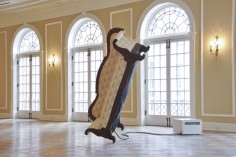Jacob Tonski
Balance From Within
source: highlike
Work: Balance comes from within. It’s a delicate act, and sometimes we fall down. A 170 year old sofa balances precariously on one leg, continuously teetering, responding internally to external forces. A meditation on the nature of human relations, and the things we build to support them.
Made possible with support by the Frank-Ratchye Studio for Creative Inquiry and the Miami University, Ohio, College of Creative Arts.
Photographer: Jacob Tonski
.
.
.
.
.
.
.
source: 7luas
O “sofá equilibrista” é uma das primeiras coisas que o visitante do FILE 2013 vê quando entra na exposição. A instalação, chamada Balance From Within (Jacob Tonski, 2012), consiste em um sofá antigo equilibrado em apenas um dos pés (o link leva para o site do artista, onde há um vídeo da obra). Embora possa não parecer à primeira vista, talvez esta seja uma das coisas mais legais no FILE em muitos anos. Principalmente porque foge da armadilha da “interatividade”, que tanto atrai visitantes (e curadores; e artistas).
.
.
.
.
.
.
.
source: playerhu
A belső egyensúly névre hallgató robotikus szobor a Miami Egyetemen tanító professzor, Jacob Tinski nevéhez fűződik. Az első, hogy az ember arra gyanakszik, hogy damillal erősítették a mennyezethez, de a magyarázat erre a látványos trükkre sokkal összetettebb. A kanapé belsejében egy reakciós kerék elnevezésű eszköz található, amit rakéták és műholdak építésekor szoktak használni, és amely a stabilizálásban játszik fontos szerepet. A szófát kissé meg is lehet lökni, a kerék segítségével visszaáll egyensúlyi állapotba. Tonski némi hátteret is adott munkájának: szerinte a szófa az emberi kapcsolatok egyik fontos színtere, amely pontosan úgy igyekszik egyensúlyát megőrizni, ahogy a hétköznapi emberek is teszik kapcsolataik során. Ahogy egy kapcsolat, úgy a bútor is össze tud törni, igaz, Tonski beépített mágnesekkel könnyedén össze is tudja illeszteni a darabjaira hullott szófát. Nem bánnánk, ha kereskedelmi forgalomba is kerülnének hasonló lakberendezési tárgyak, mert garantáltan feldobná a nappalit egy sarkán egyensúlyozó könyvespolc, fotel vagy tévéállvány.
.
.
.
.
.
.
.
source: fileorg
Abstract:
Balance is delicate, and sometimes we fall down… A 170 year old sofa balances precariously on one leg, continuously teetering, responding internally to external forces. A robotic mechanism emits a periodic low groan, softer than speech, as the piece struggles to remain upright.
Relationships are balancing acts, and delicate ones at that. This idea turned into a balancing sofa as I was thinking about how all of our social interactions can be found on these humble, ubiquitous pieces of furniture: dinner, chatting, sex, job interviews, even death. Is it surprising that we construct such a solid footing to support the delicate dance of relationships, so prone to losing their rhythm and falling down? These ideas of foundation and fragility seemed so distinct and yet inseparable; I became interested in trying to illuminate that a bit.
I began wondering if anything or anyone can balance on a rigid point, which was the technical point of departure for research. I learned that while it’s possible, it requires enormous energy and has significant limits beyond which recovery is impossible. This fact, for me, further enlightened the metaphor. As in life, the risk here is real, rather than illusory. The piece can fall and break to pieces, which must then be picked up, possibly repaired, and put back together one at a time. To regain balance, once lost, requires outside help.
Biography:
Jacob Tonski is a pragmatic optimist whose work explores dynamic balance through kinetic metaphors. Tonski holds an MFA from the Design | Media Arts department at UCLA. He studied computer science at Brown University and worked as a Technical Director at Pixar Animation Studios. He was a 2010 fellow at the Frank-Ratchye Studio for Creative Inquiry at Carnegie Mellon University. He is currently an assistant professor of Art and Interactive Media Studies at Miami University, Ohio. His creative work has been shown in China, Brazil, and throughout Europe and the United States.
.
.
.
.
.
.
.
.
source: fileorg
Abstract:
O equilíbrio é algo delicado e, às vezes, nós caímos…Um sofá de 170 anos se equilibra precariamente em um perna, oscilando constantemente em uma reação interna a forças externas. Um mecanismo robótico emite um gemido baixo periódico, mais suave do que a fala, enquanto o sofá luta para se firmar.
Relacionamentos envolvem ações delicadas de equilíbrio. Essa ideia surgiu em um sofá instável, quando eu estava pensando sobre como todas as nossas interações sociais podem se espelhar nessas peças de mobília simples e onipresentes: jantar, conversar, fazer sexo, entrevistas de trabalho e até a morte. É surpreendente que nós montemos um apoio tão sólido para a delicada dança dos relacionamentos, tão propensa a perder o ritmo e cair? Essas ideias de alicerce e fragilidade pareciam tão distintas, mas também inseparáveis, então fiquei interessado em tentar esclarecer isso.
Comecei imaginando se algo ou alguém pode se equilibrar em um ponto rígido, o que foi o ponto de partida técnico da pesquisa. Descobri que embora possível, isso requer uma energia enorme e tem limites definidos além dos quais a recuperação é impossível. Para mim, esse fato esclareceu melhor a metáfora. Assim como na vida, aqui o risco é real, não ilusório. A peça pode cair e se partir em pedaços, que então devem ser juntados, se possível consertados e recompostos. Recuperar o equilíbrio perdido requer ajuda externa.
Biography:
Jacob Tonski é um otimista pragmático cujo trabalho explora o equilíbrio dinâmico através de metáforas cinéticas. Tonski fez mestrado no Departamento de Design | Artes Eletrônicas da UCLA. Estudou ciência da computação na Brown University e foi diretor técnico no Pixar Animation Studios. Em 2010 foi pesquisador no Frank-Ratchye Studio for Creative Inquiry na Carnegie Mellon University. Atualmente é professor-assistente de Estudos sobre Arte e Mídias Interativas na Miami University, Ohio. Suas obras são expostas na China, Brasil, Europa e Estados Unidos.


